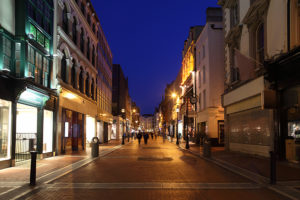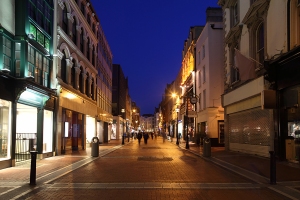Grafton Street Area, Dublin
Grafton Street is one of the two principal shopping streets in Dublin city centre, the other being Henry Street. It runs from St Stephen’s Green in the south (at the highest point of the street) to College Green in the north (to the lowest point). In 2008, it was the fifth most expensive main shopping street in the world, at €5,621/m²/year, and the thirteenth most expensive main shopping street in the world in 2016 at approx €3,300/m²/year.
History
The street was named after Henry FitzRoy, 1st Duke of Grafton, the illegitimate son of Charles II of England who owned land in the area. The street was developed from a then existing country lane by the Dawson family in 1708, after whom the parallel Dawson Street is named.
 After O’Connell Bridge (then called ‘Carlisle Bridge’) was built to span the River Liffey, Grafton Street turned from a fashionable residential street into a busy cross-city route.
After O’Connell Bridge (then called ‘Carlisle Bridge’) was built to span the River Liffey, Grafton Street turned from a fashionable residential street into a busy cross-city route.
The north end of the Street is most notable for the eighteenth-century Trinity College Provost’s House, home to the head of the college. Across the road from this is the former location of the Molly Malone statue, a well known tourist attraction and meeting-place, which was permanently moved from Grafton Street to nearby Suffolk Street in 2014, to make way for an extension to the Luas tram system. A life-size bronze statue of Phil Lynott was unveiled on Harry Street, off Grafton Street near the Stephen’s Green end, on 19 August 2005.
Bewley’s Oriental Café, a Grafton Street institution since its opening in 1927, announced at the end of October 2004 that it would be closing before Christmas, along with its Westmoreland Street café. Following a campaign by many, including the then Mayor of Dublin, Catherine Byrne, the café on Grafton Street, which had closed, was reopened, including its small performance area. Buskers, including musicians, poets and mime artists commonly perform to the shopping crowds.
This article uses material from the Wikipedia article “Grafton Street Area, Dublin”, which is released under the Creative Commons Attribution-Share-Alike License 3.0.


